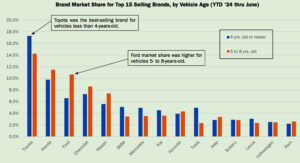New research on EV vs. ICE repair costs helps the collision repair industry understand trends
Westlake, Texas—New research by Solera Holdings has studied repair cost trends of electric vehicles (EVs) in comparison to internal combustion engine (ICE) repair costs and has found that, overall, EV repair costs are 29% higher than ICE repair costs, globally, on average.
The comparative study considered aggregate international analytics across 20 countries; approximately 92,000 raw data points (repair estimates) were examined, between January 2021 through August 2023, comparing findings of a Hyundai Kona EV with its ICE model counterpart.
“Hyundai offers consumers both ICE and EV options with some of its models. The Hyundai Kona, which received the 2023 Subcompact SUV, Editor’s Choice Awards, Car and Driver, U.S., is one such option making it an ideal example for Solera’s study,” said Bill Brower, Solera’s Vice President Global Industry Relations and North America Claims Sales.
Highlights of the EV vs. ICE Comparative Repair Cost Study include:
• Overall, EV repair costs are 29% higher than ICE repair costs, globally, on average.
• EV parts costs are 48% higher, on average, per estimate. Parts included high-voltage battery, battery-control unit, cabling, battery box, and system battery charger.
• Representing 24% of total parts cost spend, EV battery system repair costs are the highest part cost item(s) ($8.89M) compared with headlights ($2.88M).
• Driver airbag systems were replaced 8% more frequently on EVs.
• Rear bumper absorbers were replaced 1,390% more frequently on EVs.
• Rear bumper reinforcements were replaced 14% more frequently on EVs.
“There’s been a lot of industry speculation as to ‘why’ EV repair costs are more expensive than ICE repairs. The findings … offer a first-ever look at key elements shaping EV vs. ICE repair costs with a goal of helping the collision repair industry to better understand some of the trends and anomalies that can be optimized to enhance their business,” said John Felahi, Solera’s Head of Global Data Science, Analytics and Data Business.
Added Clint Ory, Solera Sr. Sales Engineer, North American Sales, “We know there were approximately 3.1 times more Kona ICE repairs performed in this time period as compared with EV repairs, allowing us to normalize the number of parts repaired/replaced to ensure a balanced data set.”
“If there’s a bright spot to EV repairs, it’s the significantly lower collision and property damage liability claim frequencies compared with their conventional counterparts (adjusted for mileage),” explained Matt Moore, Senior Vice President, Highway Loss Data Institute (HLDI).
Citing an April 2023 HLDI Bulletin, Moore stated, “Collision and property damage claim severity for electric vehicles is higher than their conventional counterparts, but only the property damage increase is significant. Electric vehicles were also associated with lower claim frequencies under all applicable coverages.
“The heavier weight of EVs may explain the higher frequency of airbag system repairs (8% more). From a physics perspective, more vehicle weight translates to more energy in crashes, more energy translates to more damage and likely a higher probability of airbag deployment.”







Comments are closed.